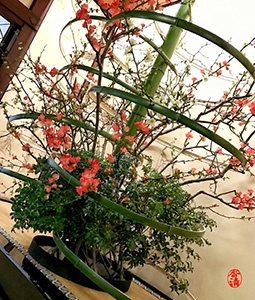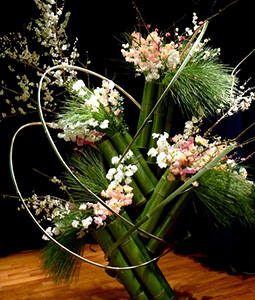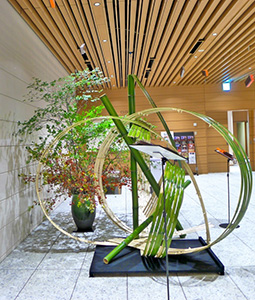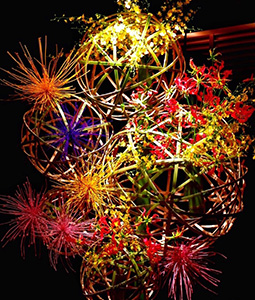April 2020
Ikebana’s Potential to Branch Out

Romanian-born Nicoleta Oprisan creates ikebana flower arrangements for a variety of occasions and has received high praise for her craft.

Ikebana is a traditional Japanese art form where emotion is created by arranging flowers, leaves, branches, and sometimes materials other than plants in a vase. Originating as Buddhist floral offerings, traditional flower arrangement was said to have been established by monks during the middle of the fourteenth century and a multitude of schools were born from differences in style and technique. The Sogetsu School of Ikebana, founded in 1927 by Teshigahara Sofu and following a novel and unrestricted style, is one of the many schools that represent ikebana today.
Nicoleta Oprisan is a certified Sogetsu School instructor, and works as a Japanese ikebana artist based in Tokyo. After graduating from the University of Bucharest with a degree in Japanese and English Linguistics she pursued her career further by coming to Tokyo. Here she studied Japanese as a post-graduate at Gakushuin Women’s College. It was at this time that she saw arranged ikebana at Sogetsu Kaikan, the hub of the Sogetsu School in Akasaka, Tokyo, and was highly impressed. Following her graduation she looked a step further and completed her MA in Mass Communications (Leicester University), a skill she finds very useful when arranging flowers—expressing emotion with the power of art.
Nicoleta says, “My grandmother always decorated our home with flowers, but ikebana is quite different from Western flower arrangement, which is created in an orderly form using multicolored flowers. In ikebana, even a single flower or branch can become a powerful expression. I greatly admired how vases with historical value were given a new life by being used to create new ikebana artworks.”
Later, she traveled around the world with her family, living in different countries until finally returning to Japan in 2007. She then enrolled in classes at the Sogetsu School. “I managed to enter my own world when I engaged with flowers during practice. I enjoyed the artistic tension borne from this zen-like moment,” says Nicoleta.
Her talent was demonstrated not long after becoming a pupil, and Nicoleta was elevated to instructor after only two years. She was then given the name “Kōsei” as an alias to work as a traditional Japanese ikebana artist. This name incorporates Nicoleta’s feelings towards ikebana as the name is made from combining the Japanese characters for aroma and purity.
Nicoleta uses her skills in a wide variety of ways. She sometimes works on large ikebana installations that are more than two meters high, for various event venues, commercial facilities and concert stages, for example. For a Valentine’s Day seasonal window display in February, she created a large heart-shaped arrangement accompanied by seasonal flowers making use of the characteristic sturdiness and flexibility of bamboo. She also created an arrangement for a hotel using autumn leaves of enkianthus perulatus alongside branches with streamlined shapes. This was highly praised by visitors, who said they could almost hear the sound of the wind through her work. Nicoleta says, “Even though it takes about two hours to make such arrangements, it takes more than two weeks for the preparations, starting with sketches. I strive to create something that is suitable for each occasion, something that will leave a lasting impression on the people who see it.”
However, ikebana that uses fresh flowers can only last for about a week. Founding 5 Senses K.K. in 2015, Nicoleta began creating textile designs with motifs based on her own ikebana arrangements to allow her works to last longer. She has also developed original perfumes inspired by the fragrant essence of her creations; the lingering scents of flower materials. Her clothing range and perfumes are sold on 5 Senses online store. She hopes to have her own brand shop in the future to emulate the 5 Senses concept, by showcasing the beauty of ikebana. She speaks of her aspirations, saying, “I want to share the importance of nature through ikebana especially nowadays when there seems to be very little time for us to ‘stop and smell the flowers.’”






